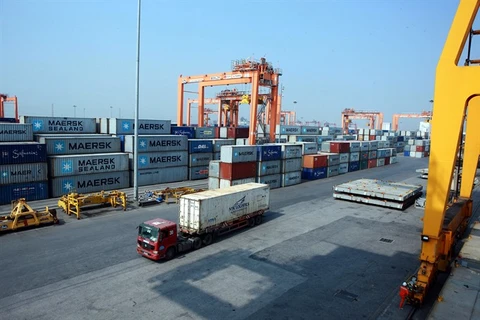Hanoi (VNA) – The State Bank of Vietnam (SBV) will keep a close watch on the developments of the domestic and global economies to work out measures to ensure stable exchange rate management in 2017, SBV Deputy Governor Nguyen Thi Hong said at a press conference in Hanoi on January 4.
She added that the exchange rate and foreign exchange market in 2016 were quite stable despite pressure from unpredictable fluctuations in the global market.
Since the outset of 2016, the SBV announced the flexible daily reference exchange rate following the developments of the domestic and overseas markets and monetary policy targets, which helped limit shocks from outside, reduce the storing of foreign currencies and support the stabilisation of the exchange rate and foreign exchange market, she noted.
Deputy Director of the SBV’s Monetary Policy Department Nguyen Duc Long said the VND/USD exchange rate rose 1.2 percent compared to the 2016 beginning. At some periods, it increased due to fluctuations in the global market such as Britain’s exit from the EU (Brexit), the US presidential election and Fed’s interest rate raising, but quickly re-stabilised after that.
Deputy Chief Inspector of the SBV’s Inspection and Supervision Agency Nguyen Van Hung said his agency set a target of thoroughly handling banks with poor performance in 2017, including three banks bought by the SBV at zero namely Viet Nam Construction Bank (VNCB), OceanBank and GPBank as well as DongABank and Sacombank.
According to the SBV, in 2016, the inspection of banking activities was strengthened and reformed, thus actively supporting the implementation of the monetary policy, restructuring and bad debt settlement.
Credit organisations witnessed positive changes such as growth in capital mobilisation, assets and improved financial capacity, while weak banks were strictly controlled and reshuffled.
As of November 30, 2016, bad debts were estimated at 2.46 percent. The Vietnam Assess Management Company (VAMC) acquired 839 debts with a total original balance of over 23.2 trillion VND (1.1 billion USD) and a combined purchasing price of 22.4 trillion VND (1.06 billion USD).
According to Hong, the interest rates were kept stable in 2016. Some credit institutions decreased lending interest rates to support business production.
The SBV used flexibly tools to regulate liquidity and keep the inter-bank interest rate at a low level, thus facilitating the stabilisation of market interest rates.
The State bank also directed credit organisations to take measures to balance capitals, stablise deposit interest rates, reduce costs and improve operational efficiency, she said.
She added that after increasing by 0.2-0.3 percent per year in the first quarter of 2016, the deposit interest rates became stable from the fourth month.
From late September, some credit institutions reduced deposit interest rates by 0.2-03 percent and lending ones by 0.5-1 percent per year for business and production and prioritised fields. The current lending interest rates stand at around 6-9 percent per year for short terms and 9-11 percent for middle and long terms.
As of December 29 last year, credit growth reached 18.71 percent. Total payment instruments and capital mobisation increased by 17.88 percent and 18.38 percent respectively, significantly contributing to curbing inflation at 4.74 percent.
In 2017, the banking sector targets a credit growth of 18 percent and total payment instruments of 16-18 percent.-VNA
VNA
























